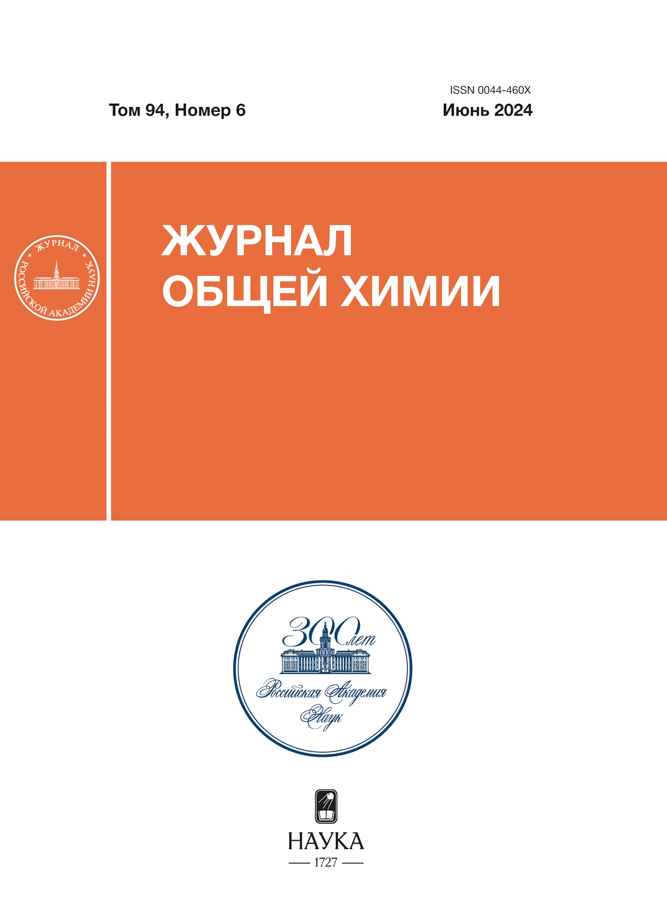Heteronuclear Glycinate Complexes of Fe(II), Fe(III) and Co(II), Their Model Parameters
- Autores: Bobonazarzoda G.B.1
-
Afiliações:
- Tajik National University
- Edição: Volume 94, Nº 6 (2024)
- Páginas: 757-765
- Seção: Articles
- URL: https://kazanmedjournal.ru/0044-460X/article/view/667393
- DOI: https://doi.org/10.31857/S0044460X24060092
- EDN: https://elibrary.ru/EYPXZF
- ID: 667393
Citar
Texto integral
Resumo
The system Fe(II)–Fe(III)–Co(II)–Gly–H2O was studied by the Clark–Nikolsky oxidation potential method at a temperature of 298.15 K, ionic strength of the solution [Na(H)CIO4] I = 1.0 mol/l. The formation of mononuclear and heteronuclear compounds of various compositions in the system was found: [FeHL(H2O)5]3+, [Fe(HL)2(H2O)4]3+, [Fe(HL)(OH)(H2O)4]2+, [СoL(H2O)5]+, [FeIIIСoIIL(H2O)11]4+, [FeIIIСoII(L)2(H2O)10]3+, [FeL(H2O)5]+, [Fe(HL)2(H2O)4]2+, [Fe(HL)(OH)(H2O)4]+ and [Fe(HL)(OH)2(H2O)3]0. The stability and model parameters of coordination compounds were calculated by the Yusupov oxidation function iteration method, and their coordination compound distribution diagrams were constructed. It was found that the heteronuclear complex [FeIIIСoIIL(H2O)11]4+ is the most stable, with an accumulation degree of 99.50%, and exists up to pH = 9.5.
Palavras-chave
Sobre autores
G. Bobonazarzoda
Tajik National University
Autor responsável pela correspondência
Email: eshova81@mail.ru
Tajiquistão, Dushanbe
Bibliografia
- Кебец Н.М. Смешаннолигандные комплексы биометаллов с витаминами и аминокислотами и их биологические свойства. Кострома, 2005. 234 с.
- Травень В.Ф. Органическая химия. М.: Бином, 2013. Т. 3. 356 с.
- Манорик П.А. Разнолигандные биокоординационные соединения металлов в химии, биологии и медицине. Киев: Наукова думка, 1991. 272 с.
- Добрынина Н.А., Зинина О.Т. Бионеорганическая химия. М.: МГУ, 2007. 36 с.
- Prasad R., Prasad S. // J. Chem. Educ. 2009. Vol. 86. N 4. P. 494. doi: 10.1021/ed086p494
- Predrag D. // Trans. Met. Chem. 1990. Vol. 15. P. 345.
- Vlado C., Ivanka P., Marko B. // J. Electroanal. Chem. 2005. Vol. 583. N 1. P. 140. doi: 10.1016/j.jelechem.2005.05.011
- Якубов Х.М., Щербакова И., Палчевский В.В., Бухаризода Р.А. // Докл. АH Тадж. ССР. 1975. Т. 18. № 4. С. 36.
- Davlatshoeva J.A., Eshova G.B., Rahimova M.M., Guriev M.O., Kvyatkovskay L.V. // Am. J. Chem. 2017. Vol. 7. N 2. P. 58. doi ???
- Никольский Б.П., Пальчевский В.В., Пендин, А.А., Якубов Х.М. Оксредметрия. Л.: Химия, 1975. 305 с.
- Захарьевский М.С. Оксредметрия. Л.: Химия, 1967. 118 с.
- Юсупов З.Н. Пат. ТJ295РТ; Б. И. 2000. 21, 8, 97000501.
- Уокенбах Д. Формулы в Excel 2013. М.: Диалектика, 2019. 720 с.
- Оффенгенден Е.Я., Раджабов У., Якубов Х.М. // Ж. коорд. хим. 1987. Т. 13. Вып. 5. С. 630.
- Заворотный В.Л., Калачева Н.А. Методическое руководство к лабораторным работам по аналитичекой химии. Титриметрический анализ. М.: РГУ нефти и газа им. И. М. Губкина, 2007. 44 с.
- Сусленникова В.М. Киселева Е.К. Руководство к приготовлению титрованных растворов. Л.: Химия, 1968. 144 с.
- Шарло Г. Методы аналитической химии. Количественный анализ неорганических соединений. М.: Химия, 1965. 976 с.
Arquivos suplementares










